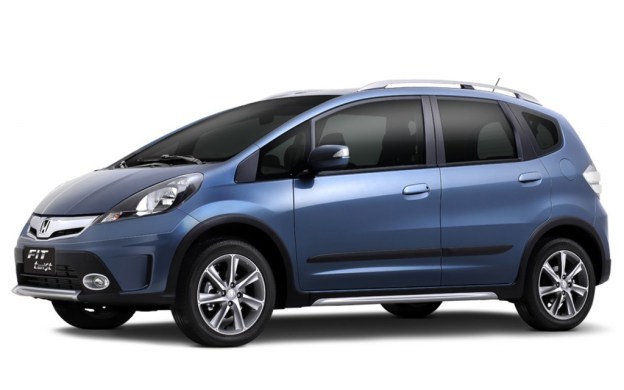 The São Paulo Motor Show is where car companies exhibit wares tailored to the Brazilian market, but Honda has come up with something that might appeal to North Americans as well. The Fit Twist is a version of Honda’s subcompact hatchback with extra ground clearance and plastic body cladding, an act we’ve seen a few times in the States.
The São Paulo Motor Show is where car companies exhibit wares tailored to the Brazilian market, but Honda has come up with something that might appeal to North Americans as well. The Fit Twist is a version of Honda’s subcompact hatchback with extra ground clearance and plastic body cladding, an act we’ve seen a few times in the States.
To give the Fit a twist, Honda added a more aggressive front bumper (which looks kind of silly on the cute-as-a-button Fit) and flared fenders with black plastic trim. From the front, it looks like the Twist’s underside is protected by a skidplate, but it’s really costume jewelry. The most functional part of the Fit’s makeover is probably the abundant black plastic, which will at least protect some of the car’s more vulnerable areas from scratches.
Honda also jacked up the Twist, although it probably won’t be much of an off-road vehicle, even with extra ground clearance. Fits are sold in some markets with all-wheel drive, but not Brazil. Honda would not say whether the Twist will be all-wheel drive or front-wheel drive.
Honda did not discuss the powertrain, either. In Brazil, regular Fits are sold with 1.4-liter and 1.5-liter inline-fours, with five-speed manual or automatic transmissions. Since the Twist treatment is mostly cosmetic, it’s a safe bet that it will use the same engines as the regular Fit.
The Fit Twist might seem like the most cynical attempt at a “crossover” ever, but Honda isn’t the first brand to try this. Subaru has been tricking Americans into buying station wagons for years with its Outback and Impreza Outback Sport. While the current Outback differs significantly from the Legacy sedan it’s based on, the Fit Twist is very much in the vein of the Impreza-based XV Crosstrek.
Then there is the Audi Allroad, which is really an A4 Avant (Audi-speak for wagon) with plastic body cladding and more ground clearance. Unlike the Twist, though, the Allroad’s skidplate is real.
The only difference between the tastes of us ‘muricans and the Brazilians seems to be size. Pseudo-crossovers based on B-segment cars like the Fit are extremely popular in Brazil. Volkswagen applied the same treatment to its Fox to create the CrossFox, and Ford has the EcoSport, which is based on the Fiesta.
These cars, big or small, can’t really go off road, so it is best not to take them too seriously. Forgetting their off road pretensions, cars like the Twist, XV Crosstrek, and Allroad look kind of cool. They also give owners the higher driving positions of SUVs, but with reasonable packaging and better fuel economy. That seems like a pretty good compromise.
In addition, Honda is planning a legitimate Fit-based crossover. The Twist will only be sold in Brazil, but this new crossover will be designed to sell everywhere. It will debut in late 2013 or early 2014 alongside a redesigned Fit.



